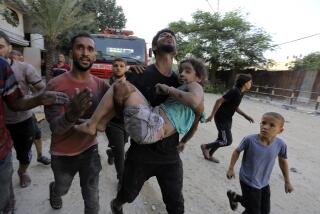A Special Haven for the Littlest AIDS Patients : Children: Hundreds of orphans are dying of the disease in Romania. After lives filled with hunger and neglect, a few will spend their last days in the warmth and comfort of St. Laurence Hospice.
- Share via
CERNAVODA, Romania — For 4-year-old Morika, dying may prove to be the best part of her life.
Just weeks ago, she was languishing in one of Romania’s nightmarish orphanages, where the only attention accorded terminally ill children was a force-feeding so brutal that they grew terrified at the sight of a spoon. She had been abandoned as an infant by alcoholic parents, along with a twin sister and an older brother. All three children were later found to have AIDS.
Morika’s siblings died last year, and doctors say she has no more than a couple of months of life herself. Yet the tiny child is oblivious of her tragic destiny.
On the contrary, she is the picture of a blissfully happy, pampered youngster.
At the St. Laurence Hospice, she now sleeps in a clean white crib with flocked sheets in a room festooned with butterfly mobiles and storybook pictures tacked to the walls.
There is another bright room, knee-deep in stuffed animals and wheeled toys, where she is learning the strange new concept of playing and beginning to regard other children as something besides occupied space. The rags she wore when she was admitted have been replaced by a lace-trimmed calico frock. Her blond hair has grown out enough from the orphanage shearing to make it obvious that she is a girl. Best of all, after a life of hunger and neglect, Morika can eat as much as she wants. When she needs changing, the task is accomplished quickly and is accompanied by a cuddle instead of a curse.
“A lot of people here can’t understand what we’re doing. They can’t understand why we’re spending so much time and resources on these children who are dying,” says Lesley Montgomery, a registered nurse from the outskirts of London who is on a six-month volunteer stint at St. Laurence. “We just want to make their last days as pleasant and painless as possible.”
St. Laurence, financed and staffed by British charities, opened in this dusty Danube River backwater in March to care for some of Romania’s legions of children with AIDS. Two of the 18 patients admitted in March have already died; three others, including Morika, are near the end.
The volunteer nurses and aides who serve at the hospice for anywhere from a month to a year say their work here is more rewarding than would be tending terminally ill children in a less damaged corner of the world.
Most of Romania’s young with AIDS were reared in conditions of appalling neglect, which has left the patients so physically and mentally handicapped as to deprive them of the ability to enjoy their eleventh-hour reprieve.
But those institutional scars are proving the swiftest to heal, giving the volunteers the immediate satisfaction of knowing they have made a difference.
Only one of the patients brought here from hospitals and orphanages around the Constanta region could walk when first admitted, although most are between the ages of 4 and 6. None had been toilet-trained or taught to feed themselves at a table. But after barely two months, at least half of the charges have learned to walk or at least toddle; words have begun tumbling out of the mouths of those once thought to be mute.
“This one wouldn’t let anyone touch her when she first came in. She used to bite me,” says Montgomery, nodding toward 3-year-old Senita, perched on another nurse’s hip and playfully tugging a necklace. “We still can’t get anywhere near her with a spoon. She has to have her food all crushed up and given to her in a cup.”
Romania’s state-run orphanages are teeming with disabled, unwanted children, many the victims of a despotic system that forced women to bear more children than they could afford to care for. During a quarter-century of tyrannical rule under Nicolae Ceausescu, birth control and abortion were outlawed in deference to the dictator’s quest for a Greater Romania of 30 million people. As many as 200,000 youngsters were dumped on state orphanages during the decade preceding the 1989 revolution that toppled Ceausescu and launched the country on a long road toward recovery.
Terminally ill children, like the AIDS babies, were banished to the worst institutions, where food and attention were too scarce to be “wasted” on those without hope. The lack of human interaction stunted their growth and often hastened the advance of their virus.
“It’s amazing how quickly they’ve made progress with a little loving care,” says Rachel Green, 19, a volunteer aide from the British Midlands. “A couple of them are demonstrating skills almost at their age level.”
St. Laurence is something of a pilot project, the nurses explain. Foreign charities want to test the effectiveness of setting up care facilities themselves, rather than funneling aid through Romanian channels that remain plagued by theft and corruption.
The $500,000 St. Laurence facility was built by the Romanian Children’s Aid Foundation of Britain, which has promised to supply and staff the hospice until Romania has recovered to the point where it can take care of its own social needs, says administrator Gheorghe Latori.
The hospice employs about 20 Romanians in clerical, janitorial and orderly positions. But the primary daytime care is provided by 16 British and Irish volunteers, most of whom know and use only the first names of their young patients. All medicine, toys, clothes, furniture and some food supplies have been ferried in by donors to avoid the pilfering that has undermined other foreign aid projects.
Cernavoda, 125 miles east of Bucharest and obscure but for a protracted nuclear power plant project, was chosen as the first hospice site because the region around the Black Sea port of Constanta has the highest concentration of AIDS cases.
Of Romania’s 1,345 registered cases of AIDS, more than 90% are younger than 12. Most of the youngsters were infected when they were injected, shortly after birth, with blood from adults; health care workers believed that the injections strengthened weak newborns. But contaminated blood from the seedy port area and generally poor sanitation were responsible for the unprecedented spread of the virus among Romania’s young, who account for more than half of Europe’s infant AIDS cases.
Even when St. Laurence is completed this summer, it will be able to care for no more than 100 children, leaving the majority of young with AIDS in the same brutal surroundings in which they suffer today.
Rodica Matusa, a Constanta doctor specializing in care for children with AIDS, has been promoting the St. Laurence project in hopes that it will spur development of a network of such facilities, effectively bypassing the Romanian health-care network that is proving slow to reform.
“It’s going to be a while before they can do this for themselves. This is a country that still fines doctors each time one of their patients dies, so once these children become very ill, they get pushed off to an orphanage so the hospital won’t have to pay the fine,” Green says as she let Vasilika, 4, drag a toy comb through her hair.
The hospice was originally intended as a place of respite for the doomed, rather than their final destination. But most of its patients come from orphanages and have no known relatives.
“They’re not supposed to stay here forever, but we expect that most of them will,” says Montgomery. “We could never send them back to die in the conditions they came from.”
More to Read
Sign up for Essential California
The most important California stories and recommendations in your inbox every morning.
You may occasionally receive promotional content from the Los Angeles Times.











